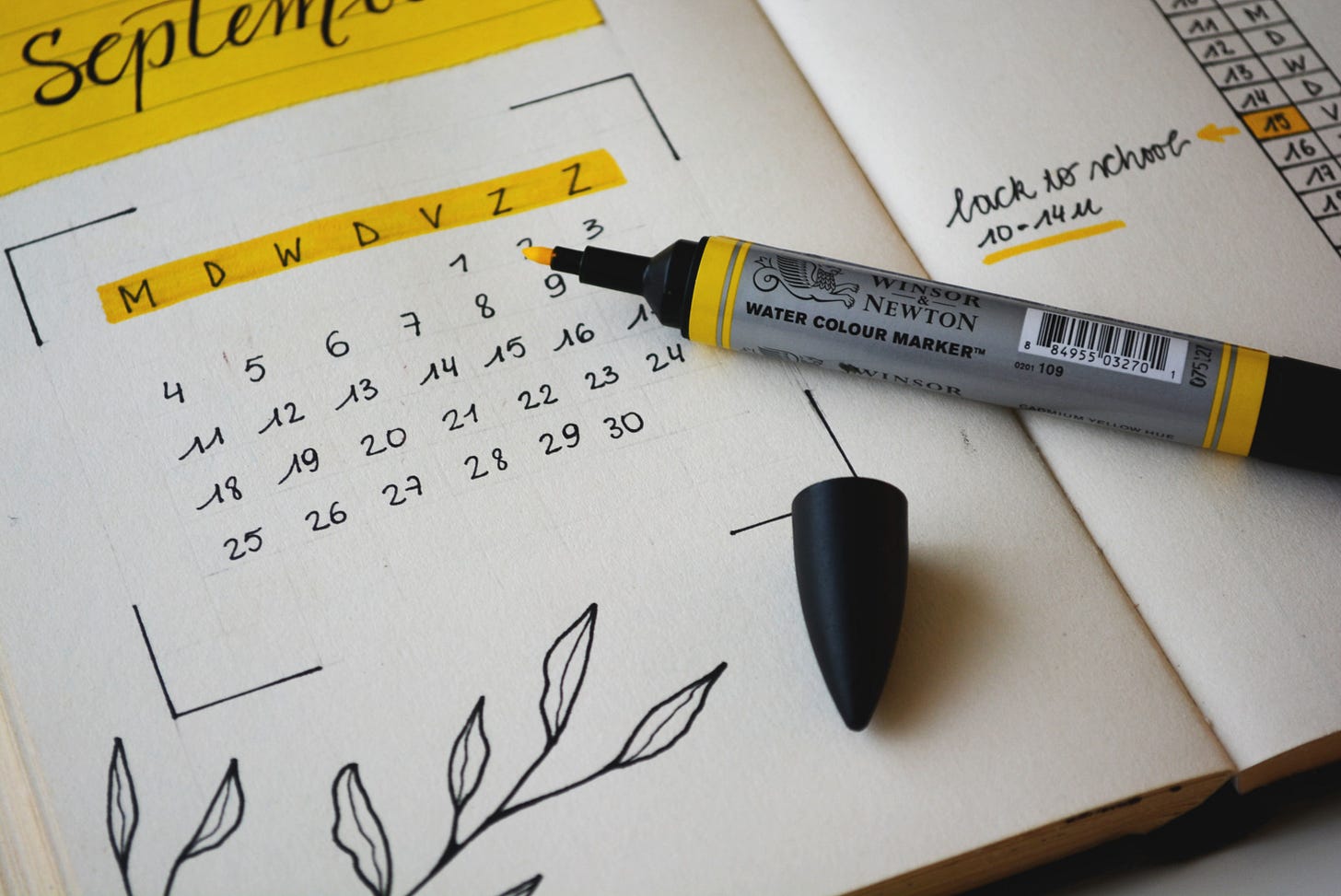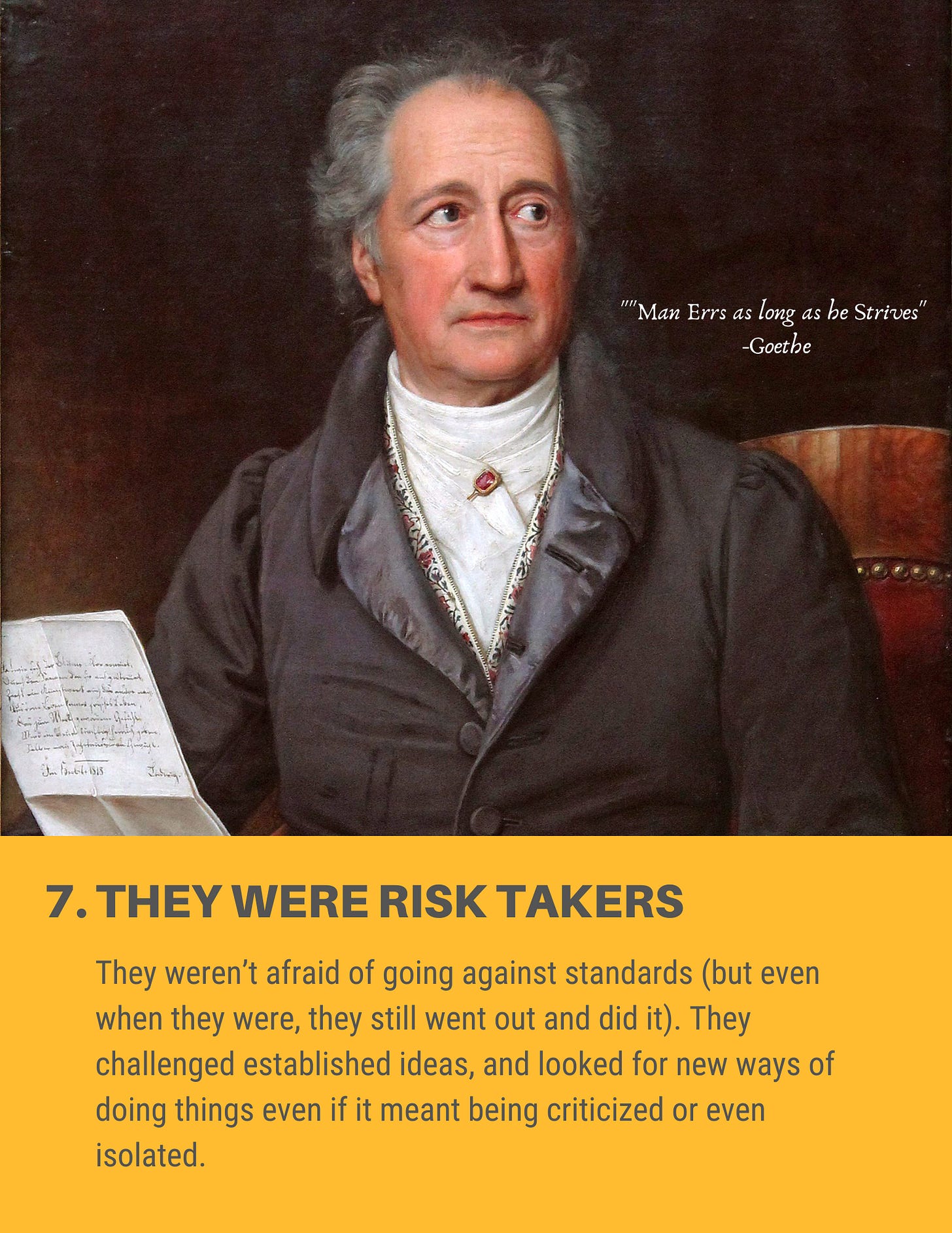This is a course on habits I created for an online academy. Since I’m not part of the academy anymore, I turned it into a post so everyone can access it.
Part I — The Principles
Introduction
Most of our behavior is directed by habits. Once we build them, they subconsciously influence our decisions and our actions. This is the benefit and the danger of habits. If you build the right ones, they will improve your life behind the scenes, but if you build the wrong ones, they can destroy it.
Habits draw their force from a compound effect: small actions every day that, when reinforced over a long enough timeframe, create lasting change. Eating junk food one day is not a big deal, for instance, but if you eat junk food every day for months or years, it will have a major negative effect on your health.
The same is true for good habits. Saving a few dollars every day may not seem like much in the short term, but if you keep doing it week after week, you can end up with a comfortable retirement, or plenty of funds for your kid’s education.
Welcome to the Mastering Habits course: The Principles and Strategies for lasting change. I’ll teach you everything I’ve learned through years researching and coaching people on how to form habits, how to make them stick, and how to use them to transform their lives.
This first part of the course will be an overview of the science and everything that goes into making and breaking habits. We’ll cover the principles: Why habits form, how they form, and the reasons you’ve had trouble creating good habits in the past—or breaking bad ones.
Part two will be about the strategies: how to build the habits you want. If you’ve failed to create habits in the past, it’s likely because you’ve been using the wrong approach, not because you lack willpower or discipline. We’ll cover the right strategies so you can finally start exercising, meditating, reading more, or any other habit goal you have.
The course is designed with the busy person in mind, with short, to-the-point, actionable lessons.
Let’s get started.
A New You
Imagine how your life would be if you finally built the habits you want. This could be working out more, eating healthier, saving more money, meditating, writing every day, learning a new language or skill, reading more, or working consistently on your side projects.
Habits hold the secret to success in all aspects of life. No one can get in shape, write a book, or become a master at a craft in a few days. All meaningful goals require consistent and persistent action over the long term.
This is the reason habits are so important. Without the knowledge to build habits that stick, we’ll never achieve the compounding effect needed to transform our lives and achieve our biggest goals.
The good news is that habits are not as difficult to build as you may have experienced in the past; it only takes the right approach and effective strategies. So, no matter how many times you tried and failed in the past, the information in this course will help you build the habits you want and make them stick.
Now, let’s stop imagining the bright future and let’s begin to build it.
“We are what we repeatedly do. Excellence, then, is not an act, but a habit.”
—Aristotle
Action Steps
Find Your Why
Take a few minutes to think about why you are taking on this new habit or why you want to get rid of one you don’t want in your life. Putting your thoughts in writing helps in two ways. On one side, writing helps develop and organize your thoughts. And on the other, having your “Why” in writing works as a reminder of your goals and the reason you chose them. So, write down your reasons and come back to them whenever you need to regain motivation and remind yourself why you should keep working on your goals.
A Better You
Now that you found your why, take a moment to envision how your life would be if you built the habits you want. How would you feel? What would be the short-term benefits of your new habit (3-6 months)? What would be the long-term benefits (1-5 years)? This exercise helps you create your vision for the future, the goal you will be moving toward.
How Habits Work
How are habits formed?
At their most basic, habits are an association between a cue, a response to that cue (which is a routine or behavior), and a result or reward from that response. All habits are composed of those three parts, called the “Habit loop”: Cue, Routine, and reward (Cue > Routine > Reward, as popularized by Charles Duhigg in his amazing book “The Power of Habit”).
Think of a negative habit, like emotional eating. You feel stressed or sad (the cue), so you go to the kitchen and stuff yourself with unhealthy food (the response or behavior) to feel some sort of relief (the reward).
Now, let’s look at a good habit. If you go for a run first thing in the morning every day, you’ll create an association between waking up and heading out to run. Waking up is the cue, running is the response or routine, and the feeling of completion at the end is the reward.
Repeating the same cycle of Cue > Response > Reward over time strengthens the action and makes it more unconscious. If you keep going for a run every morning after waking up, the routine will turn into an automatic loop that takes care of itself, and the more you repeat it, the less you resist it. You’ll wake up in the morning and, almost automatically, head out to run.
As habits get stronger, you think less about them. Your conscious mind becomes less involved, freeing up energy for other activities. At that point, you end up moving smoothly through the habit cycle—sometimes without even noticing. That’s the automation we want for all our good habits, and soon, we’ll learn how to build it.
How long it takes to build a new habit?
It depends. The popular belief is that it takes 20 days (of daily repetition) to build a new habit, but as with many popular beliefs, this fast rule doesn’t tell the whole story. It can take anywhere between 20 days to 6 months to build a new habit. It really depends on you and the habit you are trying to build. Some habits may come easily to you, others, not so much.
But don’t let these timeframes discourage you. What they are really saying is that it can take anywhere between 20 days to 6 months for a behavior to become habitual, seemingly automatic. This doesn’t mean that whatever habit you are trying to build won’t get easier to keep going the more you do it—even in the short term. So even if a new behavior takes 6 months to become automatic, it might get easier and easier to stick to it after only a few days or weeks.
In that sense, our main goal is to get our habits started the right way and remove as much resistance as possible. Soon enough, you’ll find your new behavior easier and easier to keep going until it eventually becomes a solid habit.
Why You Failed to Build Habits in The Past
Knowing is not enough
The biggest challenge with habits is that we can’t reason our way into them. Knowing which habits we want in our lives (and even why we want them) is not enough. Only repeated action, going through the cycle over and over, can build our habit and eventually take it to a tipping point where it becomes easier to do it than not to.
We know why we want a new habit like exercising more, or why we want to break a bad one like smoking. But knowing the benefits of the habits we want or the drawbacks of the ones we want to break doesn’t cut it. If that were the case, all of us would be in better shape, reading more, eating healthier, and working on our goals consistently.
Lack of motivation or understanding of why we should change a behavior is rarely the problem. Lack of consistent action is. I’m not implying that motivation or planning are not important; they are (as we’ll see later in the course). But the bulk of building and solidifying a habit lies in taking action often. Going through the habit loop (cue>response>reward) over and over until it becomes almost automatic. The strategies we’ll learn throughout the course are based on that principle. They are designed to encourage and sustain ACTION.
Remember: Wanting a new habit is not enough. Knowing the value of the habit we want to build is not enough. We must take consistent action.
Willpower is exhaustible
Another reason people fail to build new habits is that they rely on willpower too often. Willpower is exhaustible. We can think of it as the gas in our car. The fuel will keep the car going only until the tank is empty—then, the car will come to a stop. In the same way, once we’ve used our willpower for other things in our day, such as waking up early to work, tolerating difficult coworkers, and going through our commute without losing our mind, there will be little willpower left to use for sticking to our diet or going outside for a run.
If we are counting on willpower or inner strength to stick to our habits, we are setting ourselves up for failure. Willpower can help us get started or give us an extra push when we need it, but we can’t depend on it. We need more reliable strategies to create our habits and keep them going. (we’ll explore them later in the course)
Remember: Willpower can only take you so far. Use it when you need it, but think of it as a backup, not your main strategy.
Trying to create many habits at a time is counterproductive
Every year, people come up with a long list of New Year’s resolutions. They act like it’s a wishlist when they should approach it more like a budget. We have limited time and energy. We can’t do it all. Trying to pursue too many goals or build too many habits at the same time is counterproductive. You won’t give any of them the attention they need to find their place in your life.
The right approach is to start with only a few habits, focus on those, and add more as you go. Two or three habits at a time should be a good guideline. I know there are many habits you want to add to your life, and you will get to add them all. But it won’t happen if you try to add them all at the same time.
Remember: Few things at a time. Think progression. There will be time for everything, just not everything at the same time.
Too much intensity too early can lead to burnout
Going too intense too soon is a common mistake when trying to create new habits. Think of people who have never worked out in their lives and suddenly decide that they are going to start working out every single day for two hours a day. Maybe they’ll be able to push through a week or two, but more often than not, these people end up quitting.
This is similar to when we are very hungry and order too much food at a restaurant. Our mind is overwhelmed with the feeling of hunger, and it makes us believe that we can eat more than we really can. The same happens when it’s the new year and we get excited about making changes in our lives. We get pumped up about all the great things we think we can achieve. Then, high on motivation, we mentally commit to more than it’s realistically possible to take on. It’s not long before we find ourselves exhausted, frustrated, or demoralized.
Going on a habit binge is not a good strategy. A better way to build habits is to start easy and small, and build intensity only as we get better (we’ll discuss more on this later in the course).
Cramming doesn’t work
Another reason people fail to build habits is that they plan for cramming sessions instead of spreading out their new behavior over days. In a fitness example, this would be like going for a run for 4 hours once a week instead of going for a run for 2 hours twice per week or going for a run for 1 hour 4 times a week. Remember: habits are formed through consistent action.
Trying to do too much one day and then taking a long break is counterproductive. We need consistency to build habits. We’ll worry about intensity later.
Working on our habit for several hours at a time one day and forgetting about it for the following days or weeks doesn’t work. Consistency is the name of the game. It’s more effective to do our habit daily or as many times a week as possible, even if it’s for less time or less intensity.
Lack of clarity is the enemy
The last reason we’ll discuss why people fail to build habits is a lack of clarity. People think, “I want to exercise more,” and while that’s a good start, the statement is vague and doesn’t translate into specific behavior. A more accurate statement would be, “I’m going to run for one hour in the mornings 4 times a week.”
People approach habits as aspirations, without a clear plan for how they are going to make them fit into their lives. You won’t make the same mistake. We’ll translate your general goals into specific behaviors later in the course. We’ll also give them clear implementation plans so you’ll be set up for success even if you’ve tried and failed many times in the past.
Part II — The Strategies
Introduction
Welcome to the strategy section of this course. Now that you understand the science behind habits, why they form, and why you’ve had trouble creating good habits or breaking bad ones in the past, we can move into how to start new habits and make them stick.
We’ll cover many strategies, so I recommend that you first read through all of them and then choose a few (about 3 or 4) to focus on. If you try to implement too many strategies at the same time, it’s going to be overwhelming. Keep the process easy and simple at first. You can add more strategies later.
Also, everyone is different, so some strategies will resonate with you more—those are the ones you should prioritize.
At the end of this strategies section, we’ll cover how to break bad habits. The reason breaking bad habits is at the end is because the best way to break bad habits is not really to break them, but to replace them with good ones. So, we first need to learn how to create habits, and then use those to replace our bad ones.
Let’s start.
The Power of Small and Simple
The first and most important points to consider for successfully building new habits are to work on a few of them at a time, keep them simple and low-pressure, and start small.
Complexity is our enemy. Our mind doesn’t like to tackle things that are difficult, confusing, or demand too much time and energy. If you want to start a writing habit, for example, don’t think that you have to write a masterpiece every day. Your goal should only be to sit down and write. Also, don’t start with the expectation of writing every day for several hours. Start with thirty min a day and let your habit grow organically as it becomes part of your life.
Our mind also gets frustrated when it needs to juggle many things at a time. If you try to take on too many habits at once, you’ll soon get frustrated and eventually quit some of them—if not all.
If at any point you are having trouble with your habits, come back to these principles: A few habits at a time, keep them simple and low-pressure, and start small.
Contrary to popular belief, going big right away and setting the bar too high at the start makes it more likely that we quit our habits. Research shows that we are better off starting with small goals, not putting too much pressure on ourselves, and keeping the bar low. That’s how we build momentum and stay motivated to keep our habit going and grow it over time.
Explore Your New Habit
One of the first and most important strategies is to explore the habit you are getting into. Think of this as information gathering, but don’t make it an excuse to delay starting to work on your habit. You’ll be gathering information as you go.
What’s the purpose of this strategy?
Many times we get into a new habit without knowing what we should expect: the pain points we’ll face, the challenges, and everything else that awaits us. If you want to eat less sugar, for example, you should know that you’ll experience some mild withdrawal symptoms for a few days. You’ll have a headache and will also be irritable, distracted, and even tired. But as annoying as those side effects are, they don’t last longer than a few days. Knowing this before—or as you start your new healthy eating habit—is valuable. You’ll know what to expect and prepare for it when it comes. However, if you don’t know that you will experience those symptoms, the moment you feel them, you could be tempted to quit, thinking that giving up sugar is too hard. In this example, then, knowing that the hardest part of quitting sugar only lasts a few days will keep you in line and pushing through the pain period.
As a personal example, a few years ago, I set out to build the body I’ve always wanted. It wasn’t easy. People think that the hard part is weightlifting, but the real challenge is the diet. Giving up many of the foods I loved was painful. And starting to eat more of the foods I didn’t like wasn’t fun either. I didn’t think I could make it. Being such a fan of food, it didn’t seem worth it to live a life without all the gastronomic pleasures I enjoyed: Chocolate, more chocolate, and everything fried.
Here’s the part that no one ever told me: The cravings change. As you spend more time eating healthy, you begin to crave healthy food. And as you get healthier, anytime you eat unhealthy food it makes you feel terrible—so you don’t want to eat it anymore. Yes, you have a few days here and there when you want to go all out and eat everything you used to eat before, but it’s not the norm anymore. The key point I want to make is that after a few months of new eating habits, you no longer crave the old food. So technically, you eat everything you want, it’s just that what you want happens to also be good for you.
No one ever told me that would happen. I just thought it would be a long life of deprived pleasures if I wanted to stay fit. No. Your habits change you, and after a while, they are no longer something you fight to keep going but rather something that keeps you going without much effort (and in many cases, they become what you want to do rather than what you “have” to do). Had I known this change would happen after a while, it would have saved me a lot of psychological hardships.
That was a long personal story, but I hope it sheds light on any habit you are trying to build. What seems hard at the beginning progressively becomes easier and easier to do.
The main point of this strategy then, is that we need to find out more about the habit we are about to take on so we are better prepared for what lies ahead. This will help us prepare for different challenges and set up a plan that will put the odds of success in our favor.
How do we find out more about our target habit? The easiest way to do this is by talking to people who have already built the habit we want or reading about it. There’s plenty of information online, including blog posts and YouTube videos, where we can gather all the basic information about the challenges and key points of building the habit we want.
Implementation Plans
We are more likely to do something if we plan for when, where, and for how long we’ll do it. If you want to write every day, your plan could be, “I’ll sit at my desk to write every day from 8:00 a.m. to 10:00 a.m.” In this example, you state specifically when, where, and for how long you’ll write. At the same time, you are planning for consistency by doing your writing at the same time and location, making it more likely to turn into a habit.
What we are looking to achieve with an implementation plan is clarity: to make all decisions about our habits beforehand. Once we know exactly what we are supposed to do and how we are going to do it, our only job becomes showing up and following through. Everything else had been set up in advance.
A variation of this implementation plan would be to use habits and routines we already have as “time” cues instead of specific hours in the day, such as “I will write after breakfast for two hours” (instead of “I will write from 8:00 to 10:00 a.m.”). In this variation, we are turning the end of an established routine in our lives, having breakfast, into the trigger for our new habit, writing. In this variation, the implementation plan for writing would then look like this: “Every day after breakfast, I’ll sit down at my desk and write for two hours.
This habit “stacking” (adding writing after breakfast in our example) is one of the most effective ways to build new habits. It connects what we want to do with something we are already doing. With enough repetition, the “stacked” habits will form a chain where the first one automatically pushes us into the next one.
Action Step
Create your implementation plan for your habit. Think of a behavior or routine you already do that you’d like to link to your new habit. Here’s the formula: After I (habit or action you are already doing consistently), I will (your new habit).
Example: After I have breakfast, I will sit at my desk and write for one hour.
Another Example: After I brush my teeth, I will floss.
One last Example: After I leave the office, I’ll go work out at the gym for forty minutes.
Now, create your plan.
First Consistency, Then Intensity
Habits are built through long-term consistency instead of short-term intensity. Many people try to do too much too soon, making it more likely that they burn out and quit. The right approach to building habits is to focus on consistency first and adding intensity second—to start small and build upon it.
If the habit you want to build is meditation, for example, it would be better to start with 10 minutes a day for a few days or weeks before increasing the sessions to 20 minutes and beyond. This progression is more effective in building a new habit than trying to cram our way into it. If you try to start your meditation habit with the goal of meditating for 2 hours per day every day, it is more likely you’ll quit.
This was a short strategy, but it is one of the most important ones. So remember: Focus on consistency first, then progressively add intensity.
Get Back On Track As Soon As Possible
This strategy is about expecting failure and planning for it. There will come a time when we’ll break our habits. It happens. That’s normal, and we shouldn’t beat ourselves up for it. Missing a day is not a big deal, but we should be careful not to let it snowball. What happens often is that we miss a few days and fall into what’s been called, “what the hell” mode. We think that since we already missed a day or two, all is lost, and there’s no point in doing our habit for the rest of the week. We think, “I missed two days already. What the hell, I will start again next week.” We should avoid this pattern at all cost. It will turn a small sidetrack into a derailment.
If we break our habit, we must get back on track as soon as possible—and not let it escalate into more missed days. A great piece of advice from James Clear, author of Atomic Habits: An Easy & Proven Way to Build Good Habits & Break Bad Ones, is to be forgiving if we break our habit one day but never allow ourselves to break it twice in a row. Following this rule will keep us from going from missing a day of our habit to missing a week or even a month.
Remember: You’ll break your habit eventually. It’s okay. Give yourself a break. But make the commitment that you will not miss your habit twice in a row.
Failproof Your Habit
We have better chances of sticking to a habit if we make it convenient to do it and inconvenient to break. For those in bodybuilding, for example, a way to make their nutrition habits convenient is to prepare and freeze their meals in advance. When it’s time to eat, they don’t have to think about it; they take out their prepared meal and eat it.
On the other side, a way for them to make it inconvenient to break proper eating habits would be not keeping “forbidden” foods in the house. It’s hard to stick to a diet if you have a pot of “dulce de leche and brownie chunks” ice cream staring at you through the freezer drawer. But if you have to leave the house and go to a store to buy the ice cream, it’s more likely you won’t cheat on your diet.
We can use the same principle for any habit. If you want to start journaling in the morning, a way to make it convenient would be to have your desk organized with your journal and pen ready to go the night before.
Having everything set up in advance takes away resistance from your habit. It’s one less task to do before sitting down to journal, which translates into one less chance to ask yourself the downward spiral question, “Do I feel like doing it today?” The moment you ask that question, you already lost half the battle. The goal, then, is to reduce the chances of asking it by removing decisions and inconveniences around your desired habit.
As for making a habit difficult to break, we can copy the amazing writer Neil Gaiman. He reserves time for writing and sticks to a rule he set for himself: “You can sit here and write, or you can sit here and do nothing, but you can’t sit here and do anything else.” After a while of doing nothing, he explains, writing is more interesting, so he writes.
Depending on the habit you want to build, you’ll have specific obstacles, decisions, and excuses that make it harder to stick to. But the goal of this strategy remains the same: to remove as many of them as you can. The more convenient and less mentally taxing you make things around your habit, the more likely you are to stick to it. And at the same time, the more inconvenient it is to break your habit, the less likely you are to do it.
Use Your Environment
The essence of this strategy is to first recognize the power of our environment in creating or eliminating habits and then use it to our advantage. We’ll shape our environment in a way that encourages our good habits and discourages the bad ones.
Our environment influences our thoughts and actions more than we are aware of, or are willing to admit. If you are trying to eat healthy but leave a jar of Nutella out on the kitchen counter, every time you go to the kitchen you’ll see the Nutella and it will cue you to eat some. But if you put the jar away, it’s easier not to think about it or be tempted. The old saying is true, “out of sight, out of mind.”
We touched on this earlier in the previous strategy, “Failproofing your habits.” To refresh your memory, one example would be that if you are trying to start the habit of going for a run first thing in the morning, you could prepare your running shoes and clothes the night before so there’s less friction to do your habit once you wake up.
Another way to use our environment is to look for consistency in the time and place we engage with our habits. If you want to write every day, it’s easier to do it at the same time and in the same place. (For example: writing every day from 10 am to noon at your desk, or writing every day after breakfast at the local Starbucks). We are trying to remove decisions about time and place beforehand so the habit is easier to follow.
An important note to keep in mind is that our “environment” is also the people we surround ourselves with. Trying to stop smoking when all your friends smoke around you will make it really hard for you to quit. In the same way, if you want to start exercising but most people around you don’t exercise and don’t care about it, it will take more effort on your part to go against the common behavior of your social circle.
The opposite is also true. If you hang out with people who are fit, work out all the time, care about their nutrition, and place high importance on staying healthy, it will be easier for you to start and stick to any fitness habit.
We want to believe that we are stronger than the influence of our social circle, but it’s well documented that we pick up a great number of behaviors and beliefs from the people we spend the most time with ( “Monkey see, monkey do”).
It’s hard to fight the influence of our friends and family, and even if you can, there is no reason to add difficulty to building and maintaining your habits.
This doesn’t mean you have to change your friends, though some people benefit from a shakeup in their social circle. What I’m suggesting is that you at least join groups that have the same goals and value the same things you value. Keep your friends, but if they are detrimental to your habit, make sure you also spend time with people who will support your new goals. They will motivate you to keep going and can counter the bad influence from other groups (if that happens to be the case).
Remember: Our environment influences the way we think and act. Tweak it to your benefit, and it will work for you behind the scenes.
One Day At a Time
There will be days or weeks when we’ll find it difficult to stick to our habits. Our progress will seem too slow and the road too long. We need to be ready to go through these phases and still keep our habit going.
One way to stay consistent is by taking things one day at a time. This is a proven psychological strategy to overcome one of the most intense challenges a human being can endure: addiction. Recovery programs talk about “winning the day,” an approach that encourages focusing on today—the here and now. Alcoholics, for instance, are taught to direct their thinking to “I won’t drink today” and avoid obsessing about what happened yesterday or what may happen tomorrow.
Paying attention to the present moment removes the weight from the number of days they have been recovering and the pressure of having to stay sober for years to come. Thinking, “I won’t drink for the rest of my life,” is overwhelming, even scary. But if the goal is “I won’t drink today,” it becomes manageable, realistic, and doable. And once achieved, it’s a matter of renewing it day after day for months, years, and hopefully, a lifetime.
Recovering from addiction is an extreme example, but it sheds light on our psychology. Projecting work into the future can discourage us from doing it, but breaking it down into daily actionable steps will empower us. The greatest feats can be achieved if we shorten the timeframes and take it one day at a time.
With the respect and admiration that recovering addicts deserve, we’ll use their example as inspiration for achieving our own goals. We’ll borrow their strategy of short-term attention for long-term success to stick to our habits.
Rather than thinking, “I’ll do my habit day after day for months or years,” we’ll think, “I’ll do it today.” We’ll avoid thinking about the past of the future and will focus on “winning the day.” That’s all that matters.
Even with this strategy, we may feel as if the level of discipline and dedication required from us is out of reach. So, it’s important to mention that it gets more manageable with time. The more we repeat our habit, the easier it is to keep it going. This cycle takes some time to build momentum, but once it does, it’ll help us sustain our habit in the long term.
Use the Power of Small Wins
Our emotional mind is easily demoralized, especially with projects that take longer to show results. This is the case with our habits. We rarely see results immediately. When we are trying to learn a new skill, get fit, or eat healthier, for example, we don’t see the benefits right away. It takes some time to notice how our habits are changing us.
We usually pick up goals that are too big, and we focus on all the progress we have yet to make, instead of the progress we’ve already made. We don’t focus on the 10 pounds we already lost for instance, but on the other 30 we still have to drop. When the road looks too long and our progress slow, it makes us want to quit. To counter this feeling and stay motivated, we must set milestones, keep track of our progress, and above all, celebrate our small wins.
BJ Fogg, the author of “Tiny Habits,” one of the best books on habit formation out there, explains that through his research he’s found that feeling success is the best way to create a positive feeling that wires your new habits.
Do not underestimate the power of congratulating yourself every time you do your habit, even if you are doing a small version of it (like meditating for only five minutes, for example). Feeling successful will motivate you to do more of your habit.
Celebrate every step you take in the right direction, no matter how small. Your brain will soon associate the good feelings with the behavior you want to turn into a habit and encourage you to do it.
Turn It Into A Challenge
A good way to start a habit is to NOT think about it as a habit at all but as a temporary challenge. For some people, the idea of starting a habit—something they will do constantly for a long time—is overwhelming. So it can be easier to approach it as an experiment or a temporary change in behavior.
Think of the current popularity of 30-day challenges. That’s what we’ll be doing in this strategy. Take your habit, whatever it is (exercising, eating healthier, writing, meditating, Journaling, saving money), and commit to doing it for only 30 days.
A 30-day challenge (It can be a 20, 60, or 90-day challenge, your choice) is a way to kickstart a habit without thinking about it as a habit.
Reducing the amount of time we are committing to the new behavior will make it more likely that we’ll follow through. Also, the idea that it’s a challenge turns it into a type of game or fun activity, instead of a drag.
You’ll find that by the time the challenge is over, the new behavior will have found a place in your routine, and you will have started to see its benefits, making it easier to keep going.
If you don’t feel you have enough momentum to stick to the habit after the challenge, then renew the challenge for another 30 days (or however long you are making it). You can even add a change or twist to it. If your challenge was running every morning for 30 days on a particular route, for example, switch the route for the following 30 days. The idea is to create a new challenge with some variety in it so it feels like a new cycle. This is a great option to use at any time (not just starting out). If an established habit is feeling boring or hard to do because it has become monotonous, add a twist to it in the form of a challenge for a few weeks.
As an addition to this strategy, you can bring your friends and family into the challenge. That way, everyone will benefit from the environmental (in this case, social) influence we talked about in an earlier strategy. When we share a challenge with others, we keep each other accountable and motivated. It also reinforces our desire to do the new behavior because, with everyone else around us doing it, it starts to feel like the new normal.
Action Step
Create your first 30-day challenge. For example: Sober October, 30 days of no sugar, 30 days of going for a walk for half an hour a day, and so on. Ask some friends and family to join you in the challenge if you can. It will make it more motivating and fun, and it will keep everyone accountable.
Focus On Progress, Not Perfection
Here’s a reality of building habits: We’ll stumble every now and then. And the same goes for breaking undesired habits. We’ll sometimes fall back into our old ways. It happens to everyone. The goal is not trying to be perfect but to expect and prepare for the times we fall short.
When we accept some stumbles along the way as an inevitable part of changing and improving, we’ll be more forgiving of ourselves, which in turn will help us keep our motivation.
The search for perfection is our enemy. It prevents us from taking action and sets an impossible standard that results in self-criticism and demotivation. Yet, we often judge ourselves against the impossible standard of being perfect…all the time.
For our goal of establishing new habits, we’ll forget about being perfect. Our only focus should be progress. Am I working on my habit consistently? If the answer is yes, even if we are taking very small steps and we are far from perfect, we are on the right track.
We need to remember that great achievements come from small improvements compounded over time. Striving for progress is what ultimately leads to achieving all other goals.
Forget perfection. Contrary to popular belief, aiming too high from the start often results in quitting. The goal seems insurmountable. A better approach is to start small, focus on consistency, and raise your standards along with your progress.
It seems counterintuitive, but it’s better to set the bar low at the start because It will motivate us to reach it. And once we do, it will keep us motivated to reach a little higher and so on.
None of this is to say that we should be complacent and not demand the best from ourselves. I am not suggesting that we KEEP the bar low, but that we should set it low at the start to get the small wins and stay motivated.
Rewards And Penalties
Ideally, we should be motivated by the goals we set for our future—the reason we started the habit. There should be no need for rewards or penalties. But the reality is that we’ll go through times of frustration and discouragement, and we’ll need an extra push. It’s during these times that rewards and penalties can keep us going until we regain our intrinsic motivation.
On the rewards side, we should use something that encourages more practice. If you have the goal of painting every day, your reward could be to buy a new set of brushes or better-quality paint if you stick to your habit for a month. Using those new painting tools as a reward will encourage more painting and keep the habit going.
Opposite to rewards, some people find it easier to stick to a habit when facing a penalty for not doing so. This could mean donating to a cause you disapprove of, not eating your favorite snack for a week, or any penalty that comes to mind. It doesn’t have to be harsh—even small penalties can go a long way.
Try rewards, penalties, or both if you are having trouble sticking to your habits and need the extra push, but make sure not to rely on them often. Rewards or penalties should only be used to give us a boost when we need it.
Remember Your Why
When creating a new habit, you will have easy days and hard days. The easy days take care of themselves. It’s the hard days, the days when we can’t find our motivation or keep making up excuses to not do our habit, that we need to prepare for. Rewards or penalties (the previous strategy) can give us the extra push to keep going. But they are only external motivators. Here, we’ll take a look at our internal motivators.
This strategy, “Remembering your why,” is exactly what it sounds like. When your motivation is at its lowest and you are making excuses to avoid your habit, you need to revisit your grand vision for your life and remind yourself of your greater goals. You want to be healthier, fit, more knowledgeable, save more money, or manage stress. Whatever your motivation to start your new habit in the first place, bring it back to mind. Try to feel the excitement you felt before you started, the world of possibilities you dreamed of, and the trust you put in yourself to follow through on your commitment.
As an added point for motivation, look at your heroes. The influencers or simply the people you admire who have succeeded in building habits themselves. Those who work at improving their lives every day. As a personal example, I look up to Dwayne Johnson (The Rock) for my working out habit. And to Ryan Holiday (Bestselling author of “The Obstacle is the Way”) for my reading and writing habit.
Whenever I feel like taking it easy or breaking my habits, I think of them. I imagine them working on their habits daily and beating resistance. It gives me the extra push I need to feel motivated again and stay on track.
Action Step
1. Think back to what made you want to start this habit in the first place. Try to relive the emotion as strongly as you can. Don’t just “think” why you got started, FEEL again that drive, that defining sensation that made you decide you wanted to transform your life.
2. Think of the people you admire most. Bring them to mind and let them motivate you. Feel how they encourage you, how they set a standard you want to live up to. You can even think of them encouraging you directly; telling you to keep going and not give up.
Embrace Your New Identity
The last strategy we’ll discuss is embracing a new identity. Making lasting change requires that we start to see ourselves in a new light. We have to imagine ourselves being who we want to become. And if we want to accelerate our progress, we need to embrace that new identity as soon as possible.
Embracing a new identity means starting to think of ourselves as the type of person who engages in our desired habit consistently. And think of it not just as something we do but as something or someone we are. If you want to exercise every day, for example, you have to start thinking of yourself as the type of person who exercises every day. Or if you want to write every day, you have to start seeing yourself as the type of person who writes every day. And so on.
When we change our self-image, it’s easier for our behaviors to follow. Let’s look at an example. Imagine you want to paint every day. If you start seeing yourself as a painter or simply as someone who paints every day, that new identity encourages you to do the actual work. If you think of yourself as a painter, you would ask, “What does a painter do?” well, he or she paints.
I want to take a moment to clarify that I am not talking about the law of attraction here. The point I’m making is that how we perceive ourselves has a great influence on the actions we take. Someone who considers himself lazy and has built that into his identity is more likely to act lazily. And someone who thinks of herself as a healthy eater is more likely to buy and eat healthy foods.
We like to act in accordance with who we think we are. At the same time, acting contrary to our beliefs and perception of ourselves creates something called cognitive dissonance, which is a very uncomfortable state of mind. When we experience this cognitive dissonance, we are left with two choices to relieve the tension: either change our identity or change our behavior. We can’t live with inner incongruence for long. So the strategy here is to shape a new identity to support our new habit. Think of yourself as the kind of person who does the habit you want to build. For example: I am a writer, I am a health enthusiast, I am a fitness junkie. Or simply, “I am the type of person who does X (X being your desired habit)”
You’ll find out that once you change your self-image, it is easier to stick with the behaviors that support it.
Extra Strategy: Make It A Daily Routine
It seems counterintuitive, but if you find it difficult to stick to your habit a few times a week, try doing it every day (even if it’s for less time, or less intense). You’ll find that a daily routine is easier to stick to. It removes any decision of “Do I feel like it today?” It also removes all excuses. You just know you have to do it every day, whether you are inspired or not, tired or not, feel like it or not.
And this is true for fitness, dieting, learning new skills, or anything else. If you do your habit daily, you’ll find that it becomes easier and easier to keep doing it. That is the power of momentum. But when you take a break, you’ll want to stretch that break longer and longer. In that sense, the “few times a week” schedule can be harder to stick to than a daily one.
You may not be looking forward to doing your new habit every single day, but it takes less effort than you think. After a few weeks, you accept it as part of your normal routine.
As a personal example, I work out daily. I don’t take breaks because I find it harder to restart after taking a day off. If I skip a day, I then want to skip the next one, and then the one after that. But when it’s every day, I accept it as part of what I do regularly. People think I’m disciplined because I work out every day, but it’s the opposite. It’s because I don’t have the discipline to work out two or three times a week following a schedule that I need to work out daily.
There’s a popular story about how Jerry Seinfeld approached his writing habit. He relied on a simple calendar and a red marker. All he would do was put a big red X in the calendar for each day he wrote. Seinfield’s goal was to never break the chain of red Xs. That’s it.
This can sound unrealistic or simplistic if you’ve never tried it, but you would be surprised by the power of a visual reminder to stick to a habit.
Not everyone is interested in doing their habit daily, but if you are one of those people, a habit tracker (you can find several online) or a simple calendar can help you stay in line.
In any case, doing your habit every day without a break may not be your choice, but you should give it a try to realize that it’s not as difficult as you imagine. Do keep in mind to lower the intensity of your habit. If you were exercising 3 times a week for 2 hours, for example, do one hour every day instead. You would be spending the same amount of time exercising, but you would be focusing on turning your routine into a daily habit.
“It’s either every day or never” —Andy Wharhol
Action Step
The exercise for this strategy is simple. If you’ve decided to try doing your habit daily, get a calendar (ideally, a physical one) and mark an X every day you do your habit. Your only mission, as Seinfield explained, is to not break that chain of Xs.
You’ll find that using a physical calendar and having to mark the x by hand is more meaningful than if you put it on a digital file. It’s not a requirement, however. You can do it in a physical or digital calendar. Your choice.
Breaking Bad Habits
Regardless of how many times you’ve tried and failed to break bad habits, you are not stuck with them. It’s likely you’ve been using the wrong approach, and that’s why it’s been so difficult to get rid of them. Most people think the way to break bad habits is through sheer willpower, but that’s the worst approach. Let’s look at more effective strategies.
Remove the cue
Remember from our habit loop discussion earlier in the course (cue>Response>Reward) that the cue is what gets a habit started. The first option for fighting bad habits, then, is to get rid of its cue. If you’re trying to cut down on snacking, for instance, this means avoiding snacking cues. One of those cues could be seeing chips or cookies on the kitchen counter. In this case, putting your snacks out of sight will help you cut down on snacking because you won’t be constantly reminded to do so. Out of sight, out of mind.
Make your habit hard to do
Another option for fighting bad habits is to make them inconvenient, difficult, or expensive.
In the case of snacking, a way to make the habit inconvenient would be to not have snacks at home in the first place. So if you really want snacks, you’d have to drive or walk to the store to buy them. It’s likely you won’t.
Don’t underestimate the effectiveness of this strategy. Even small inconveniences go a long way in getting rid of a behavior.
Swap the habit
Removing cues and making your bad habits inconvenient are your first options for breaking undesired habits. But we know this is not always possible. Many people like eating cookies or some kind of sweets after a meal, for example. For them, finishing a meal is the cue for reaching out for sweets, and because they eat meals every day, they are constantly reminded to eat sweets afterward.
If we can’t get rid of the cue for our bad habit, we’ll focus on changing our reaction to it. In the example above, the cue is unavoidable—we have to eat every day—but we can start replacing what we do after eating. Instead of reaching for sweets once we finish a meal, we can brush our teeth so we don’t want to eat more or chew gum so our mouth is already occupied with something. After some time, we’ll create a new connection between the cue “eating” and the behavior we’ve been attaching to it, chewing gum or brushing our teeth.
Think of this strategy as habit-swapping. We are leaving the same cue from the habit we want to break, but change our reaction to it. After a meal, instead of picking up a cookie, we take out chewing gum or go brush our teeth. The cue stays the same, and we only replace one behavior with another.
I know that this sounds simple in theory and that, in practice, it is much harder. Yes, replacing habits is challenging. It will take work and perseverance. And sometimes, we may stumble back to our old ways. But the important point is that replacing a bad habit is much easier than eliminating it. And though replacing a habit is still difficult, it gives us a better chance of success than trying to get rid of it altogether. Take it slowly, celebrate your progress, and be forgiving of the times you falter.
Since the goal is no longer to get rid of a habit but instead replace it with something you want, all the strategies you’ve learned in the course will help you build the new habit to replace the bad one.
Action Step
Choose a habit you want to replace a bad one, then review the strategies in the course to create and strengthen the “replacement” habit.
Part III — Bonus Material
Strategies Cheat Sheet
The Power of Small and Simple
Work on a few habits at a time, keep them simple, and start small.
Explore Your New Habit
Find out what you are getting yourself into and what challenges will come your way so you are better prepared to face them
Implementation Plans
We are more likely to stick to a habit when we know when, where, and for how long we’ll do it.
Example: I’ll write every morning at my desk for two hours right after breakfast.
First Consistency, Then Intensity
We build habits through consistent action, not sporadic binges. Focus on doing your habit consistently first, and once it starts becoming routine, increase the intensity.
Get Back on Track as Soon As Possible
We’ll break our habit at some point. It happens. Don’t beat yourself up about it, but make sure it doesn’t snowball. Get back on track as soon as possible.
Fail-Proof Your Habits
Make your habit easy to stick to and hard to break. Example: If you want to avoid unhealthy food, don’t keep any of it at home.
Use Your Environment
Keep the time and location of your habit consistent to make it easier to stick to. Also, surround yourself with people who do the habit you want to build. A supportive environment makes it easier to create and maintain our target habits.
One Day at a Time
Don’t think about yesterday or tomorrow. Focus on doing your habit today. Focusing on daily actions is empowering. We can achieve even the greatest feats if we think of them in short timeframes.
Use the Power of Small Wins
Our emotional mind is easily demoralized. We need to constantly celebrate our small wins to stay motivated. Acknowledge your effort and progress often, it will keep you on track to greater improvement.
Turn it Into a Challenge
An easy way to kickstart a habit is to turn it into a temporary change. Turn your desired habit into a 30-day challenge and invite others to join you to make it even more fun.
Focus on Progress, Not Perfection
Trying to be perfect will make you miserable. We all make mistakes and break our habits every now and then. It’s normal. Focus on making progress instead, it will take you further than trying to be perfect.
Embrace Your New Identity
Think of yourself as the kind of person who does the habit you want to build. When we start seeing ourselves through the lens of the person we want to become, our mind will progressively gear us toward it.
Rewards and Penalties
Whenever you need a boost to stick to your habit, incorporate small rewards for following through and/or penalties for not doing so.
Remember Your Why
We’ll have times when our motivation will hit low points. When that happens, remember your grand vision. Why did you take on the habit in the first place? Who did you want to become, and why? Revisiting the inspiration that made us choose our new habit in the first place will recharge our motivation.
Extra Strategy: Make it a Daily Routine
If you are having trouble being consistent with a habit, try turning it into a daily routine. For many people doing something every day is easier than a few times a week.
Remember: You can adjust the intensity and time commitment so you are able to do your habit every day. Example: Instead of working out 3 times a week for an hour and a half, you can do 30-minute workouts every day.
Habits Quick-Start Worksheet
1. What’s your general goal?
Example: lose weight.
2. Why do you want to build that habit?
Find a strong reason that will keep you motivated Example: I want to look better in the mirror and improve my health so I can have more energy for my kids.
3. What’s your specific goal?
Example: Lose 20 pounds in the next 3 months.
4. What are the different possible paths (habits) that can take you there?
Example: To lose weight, you have to move more or eat less (or both). There are many different programs to move more (weightlifting, cardio, CrossFit, etc). And there are many diets out there to help you lower your calorie intake. The goal of this step is to consider the different options available so you can then choose the one that fits your preferences and lifestyle the most. Some examples: Cut sugar, or do CrossFit 3 times a week, or do cardio every day for thirty minutes, or work out at the gym twice a week, or lower my daily calorie intake by 200 calories, or a combination of the above, etc.
5. What is your preferred path?
From the different options you identified in question 4, choose the ones you want to turn into habits. Example: Do CrossFit 3 times a week.
6. What’s your implementation plan?
In this step, you are designing your habit, After I do X, I will do Y (refer to the “Implementation Plan Strategy”). Example: I’ll go to CrossFit class on Mondays, Wednesdays, and Fridays after I leave work.
7. Take consistent action
We love planning, but we avoid taking action. Remember though, consistent action is what turns behaviors into habits. Keep building momentum by engaging with your new habit consistently.
8. Start implementing the strategies in this course
This course introduced you to many strategies and tactics. Choose a few to work on and start implementing them. Example: You could start with these three, “Failproof Your Habit,” “Turn it into a Challenge,” and “Focus on Progress, not Perfection.”
9. Celebrate small wins
Our emotional mind needs to feel good about the progress we make, even if small. So make sure you take time to acknowledge and celebrate your improvement. Example: Congratulate yourself every time you finish a class, go out for a well-deserved nice dinner with your partner after every week you are consistent with your habit.
F.A.Q (Frequently Asked Questions)
What else can I do to get better at sticking to my habits?
Sticking to our habits is harder when we are unhealthy, sleep-deprived, and stressed. And all these three factors work in combination:
We crave sugars and fried food when we are stressed and lack sleep.
We have poor sleep when we eat unhealthily and feel stressed.
We are less likely to cope with stress when we eat unhealthy food and have bad sleep.
The good news is that the cycles also work in reverse: Eating better helps us reduce stress and promotes better sleep, and so on. Ideally, we want to work on all three components (nutrition, sleep, stress), but even starting with one will have a big influence on the other two.
You’ll notice that as you improve these areas you’ll have more energy, more determination, more motivation, and more willingness to take action and change your life.
What habit should I start with?
Most likely, you already have a habit you want to create or one you want to break, but if you are looking for a recommendation, here it is: Exercise.
Exercise is the gateway habit to everything health-related that will improve your body and mind. After exercising regularly for a couple of weeks, you’ll notice that you start to crave healthier foods, thus improving your nutrition. Exercise also improves sleep, mental health, and sex life. At the same time, it reduces stress and anxiety.
Exercising is the best thing you can do for yourself. And though it has plenty of benefits on its own, the extra vitality and drive you’ll get from exercising will also motivate you to take on other new habits and become a new you. I cannot recommend exercising enough.
What books do you recommend on habits?
Here are my three favorites:
Tiny Habits by B.J. Frogg
The Power of Habit by Charles Duhigg
Atomic Habits by James Clear
If you want more book recommendations, I compiled the books I like and used as a knowledge source for this course under the last lesson called “Recommended Reading & Source Material”
There are many strategies in this course. Which ones do you recommend starting with?
Different strategies work better for different people, but the top three I recommend everyone to start with are:
“The Power of Small and Simple”
“Implementation plans”
“Focus on progress, not perfection”
Those three strategies are enough to jump-start your new habit and make it stick.
I don’t think I can change, I’m too set in my ways, would this work for me?
Yes. Definitely. We all have the ability to change, but the first thing you need to leave behind is the belief that you can’t change. Holding on to the idea that you are set in your ways will work as an excuse to self-sabotage and quit your new habit.
Once you believe you can change, however, you are opening yourself up to work hard and improve. If you need reassurance that you can change, here it is: You have the power to transform your life if you are willing to work for it. Everyone can improve their lives regardless of who they are or how long they have been stuck in old patterns of behavior. I promise you that you can change, I believe in you. Now it’s time you believe in yourself and take consistent action.
Recommended Reading And Referenced Material
Frogg, B.J. Tiny Habits: The Small Changes That Change Everything. New York: Houghton Mifflin Harcourt Publishing, 2020
Duhigg, Charles. The Power of Habit: Why We Do What We Do in Life and Business. Canada: Doubleday, 2012.
Clear, James. Atomic Habits: An Easy & Proven Way to Build Good Habits & Break Bad Ones. New York: Avery, 2018.
Dean, Jeremy. Making Habits, Breaking Habits. Why We Do Things, Why We Don’t, and How to Make Any Change Stick. Boston: Da Capo Press, 2013.
Rubin, Gretchen. Better Than Before: Mastering the Habits of Our Everyday Lives. Canada: Doubleday, 2015.
Baumeister, Roy, and John Tierney. Willpower: Rediscovering the Greatest Human Strength. New York: Penguin, 2011.
Wiseman, Richard. :59 Seconds: Think a Little, Change a Lot. United Kingdom: Pan Books, 2010.
Heath, Chip, and Dan Heath. Switch: How to Change Things When Change is Hard. New York: Random House, 2010.
Currey, Mason. Daily Rituals: How Artists Work. New York: Alfred A. Knopf, 2014.
Hardy, Benjamin. Personality isn’t permanent: Break Free From Self-Limiting Beliefs And Rewrite Your Story. New York: Portfolio, 2020.
Maltz, Maxwell. The New Psycho-Cybernetics: The Original Science of Self-Improvement and Success That Has Changed the Lives of Over 30 Million People. Prentice Hall Press, New York 2001.
Mcguinness, Mark. Resilience: Facing Down Rejection & Criticism on the Road to Success. Lateral Action, 2012.
Dweck, Carol. Mindset: The New Psychology of Success. New York: Random House, 2006.
Duckworth, Angela. Grit: The Power of Passion and Perseverance. Canada: Collins, 2018.







































